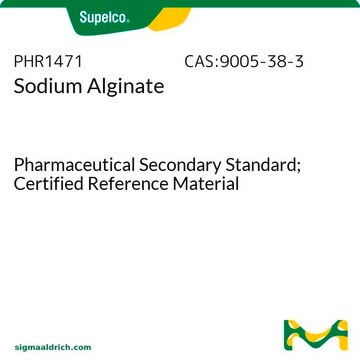If this product has an expiration or retest date, it will be shown on the Certificate of Analysis (COA, CofA). If there is no retest or expiration date listed on the product's COA, we do not have suitable stability data to determine a shelf life. For these products, the only date on the COA will be the release date; a retest, expiration, or use-by-date will not be displayed.
For all products, we recommend handling per defined conditions as printed in our product literature and website product descriptions. We recommend that products should be routinely inspected by customers to ensure they perform as expected.
For products without retest or expiration dates, our standard warranty of 1 year from the date of shipment is applicable.
For more information, please refer to the Product Dating Information document: https://www.sigmaaldrich.com/deepweb/assets/sigmaaldrich/marketing/global/documents/449/386/product-dating-information-mk.pdf
71238
Ácido algínico sodium salt from brown algae
BioReagent, suitable for immobilization of micro-organisms
Sinónimos:
Algin, Alginato de sodio
Seleccione un Tamaño
Seleccione un Tamaño
About This Item
Productos recomendados
origen biológico
algae (brown)
Línea del producto
BioReagent
Formulario
powder
residuo de ign.
≤30%
pérdida
≤15% loss on drying
color
white to light beige
pH
6.0-8.0 (10 mg/mL in H2O)
idoneidad
in accordance for gelation test
suitable for immobilization of micro-organisms
temp. de almacenamiento
room temp
cadena SMILES
[Na+].[O-]C(=O)C1O[C@H]([C@H]([C@H]([C@@H]1O)O)O)O
InChI
1S/C6H10O7.Na/c7-1-2(8)4(5(10)11)13-6(12)3(1)9;/h1-4,6-9,12H,(H,10,11);/q;+1/p-1/t1-,2-,3-,4?,6+;/m0./s1
Clave InChI
MSXHSNHNTORCAW-MPGIDXPLSA-M
¿Está buscando productos similares? Visita Guía de comparación de productos
Aplicación
Otras notas
Código de clase de almacenamiento
11 - Combustible Solids
Clase de riesgo para el agua (WGK)
WGK 1
Punto de inflamabilidad (°F)
Not applicable
Punto de inflamabilidad (°C)
Not applicable
Equipo de protección personal
Eyeshields, Gloves, type N95 (US)
Elija entre una de las versiones más recientes:
¿Ya tiene este producto?
Encuentre la documentación para los productos que ha comprado recientemente en la Biblioteca de documentos.
-
How can I determine the shelf life / expiration / retest date of this product?
1 answer-
Helpful?
-
-
How is shipping temperature determined? And how is it related to the product storage temperature?
1 answer-
Products may be shipped at a different temperature than the recommended long-term storage temperature. If the product quality is sensitive to short-term exposure to conditions other than the recommended long-term storage, it will be shipped on wet or dry-ice. If the product quality is NOT affected by short-term exposure to conditions other than the recommended long-term storage, it will be shipped at ambient temperature. As shipping routes are configured for minimum transit times, shipping at ambient temperature helps control shipping costs for our customers. For more information, please refer to the Storage and Transport Conditions document: https://www.sigmaaldrich.com/deepweb/assets/sigmaaldrich/marketing/global/documents/316/622/storage-transport-conditions-mk.pdf
Helpful?
-
-
What is the viscosity of the alginate?
1 answer-
The viscosity is not determined for this product on a lot specific basis. However, the viscosity is generally between 100 - 200 mPa sec for a 1% solution at 20°C. Please note that the viscosity is not a listed test specification and has not been validated.
Helpful?
-
-
What is the viscosity of this product?
1 answer-
The viscosity of product is not tested on a lot specific basis, however historical values indicate a range of 100 - 200 cP at 1% in water, 20 °C.
Helpful?
-
-
WHAT IS THE MANNURONIC ACID TO GULURONIC ACID (M/G) RATIO OF THIS PRODUCT (71238)?
1 answer-
The guluronic acid content in this product is approximately 70 % and the mannuronic acid content is approximately 30 %
Helpful?
-
-
What is the average molecular weight?
1 answer-
The molecular weight is approx. 100,000 - 200,000 g/moL.
Helpful?
-
Active Filters
Nuestro equipo de científicos tiene experiencia en todas las áreas de investigación: Ciencias de la vida, Ciencia de los materiales, Síntesis química, Cromatografía, Analítica y muchas otras.
Póngase en contacto con el Servicio técnico






